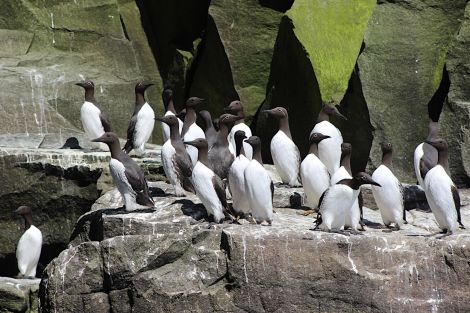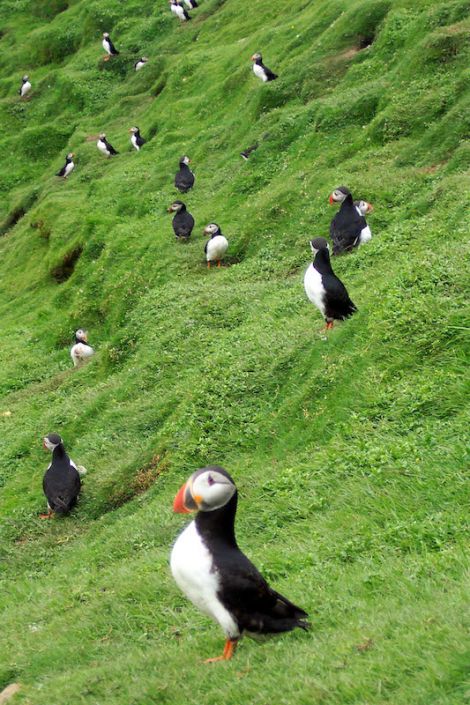News / Seabird picture more complex than reported
SHETLAND is still a fantastic place for birdwatching and wildlife, according to local experts, and far from the seabird desert portrayed by a recent article in The Observer and on the www.theguardian.com website.
But a major census, the first since 2000, ought to bring clarity to the situation. It is largely being conducted by volunteers owing to the shortage of government funding.
There are also fears that if the negative picture portrayed in the Observer and the Guardian website goes unchallenged, it could damage numbers of visitors who come to Shetland for the birdlife.
Will Miles, the man who monitors seabirds for environmental group SOTEAG, said that there are in fact thousands of seabirds breeding at Sumburgh Head – the principle focus of the article’s claims of seabird desertion.
Miles, who took over as SOTEAG monitor in March but has worked in Shetland and Fair Isle for a number of years, said that the story had created a stir in bird circles but had exaggerated the position regarding many of the seabird species.
He said that contrary to the reported fewer than 600 puffins in Shetland, there were an estimated 500 at Sumburgh and over 1,000 in Noss.
Miles said: “The puffin statistic is one that is factually incorrect. The notion that no seabirds are breeding at Sumburgh is also nonsense. There are thousands of seabirds breeding this year, including puffins.
“Granted, over the past 30 years certain species have declined dramatically, but there are still thousands of birds at that site.”
According to Miles there is little doubt global warming is behind plummeting seabird numbers. Warm sea temperatures are hitting plankton numbers and that is the main food of the oily fish like sandeels and juveniles of the cod family that are the staple diet of terns and other small seabirds.
Become a supporter of Shetland News
There is a disjunction between the rearing period of the birds in June, July and August and the declining availability of sandeels and that is leading to a drop in breeding success, he added.
The decline in kittiwakes and guillemots, in particular, has been extreme with kittiwakes down to just over 200 at Sumburgh Head.
Shetland, he said, is still a fantastic place to see seabirds with the ease of access to Sumburgh Head making it one of the top sites for visitors to Shetland.
Jonathan Wills, who for over 20 years ran the Seabirds and Seals tour operation around Bressay and Noss and was the first warden in the reserve, said the situation was more complicated than the article suggests.
He said: “The article was illustrated with a picture of the Noss gannetry – not Sumburgh Head – which has around 25,000 gannets in it, double as many as there were when I worked at Noss IN 1970.
“It is true that puffin numbers are down as are kittiwake and razorbill numbers. The biggest decline is for kittiwakes, from about 20,000 at Noss in the 1970s to around 200 now.
“The birds most dependent on sandeels during the breeding season have suffered most.”
He went on to say that fishing had and continues to have an effect. While there is no local sandeel fishery any more, the species continues to be targeted by other nations.
The “success of the Common Fisheries Policy” means that there is more whitefish in the sea. Cod and haddock are predators too, and their abundance will ultimately have an impact on sandeel numbers, he said.
Also, the unusually high number of bonxies (greater skua) and greater black back gulls in Shetland is having an impact on the success of the other species.
In his view, bonxie numbers grew dramatically as a result of the wasteful klondyking operation dumping offal over board in the 1980s and 1990s.
According to Wills, the moment klondyking was over, in 1995, bonxies and black backs turned on kittiwakes, puffins and razorbills to survive.
“Bird populations are not ‘natural’, they are the result of human activity,” he said.
Shetland Wildlife Tours operator Hugh Harrop said exact bird numbers were difficult to quantify. “Undoubtedly there are devastating declines, but there are also encouraging increases.”
What was important was to open people’s eyes to the serious trouble seabird populations were in, not just in Shetland, but throughout the North Atlantic.
RSPB manager for Shetland Helen Moncrieff said that proper scientific methodology had been applied for the organisation’s statistics. Despite that, caveats had to be applied, particularly when considering puffin figures, which showed a drop from 33,000 birds to 570 over 17 years.
She added: “Puffins are notoriously difficult to count accurately and counts can be highly variable even on the same site over the course of a day. The variation makes it difficult to infer a true population change based on counts of individuals between years.
“The counts were done at different times of year; June in Seabird 2000 and May in 2017. The June count will have included non-breeders in greater numbers compared to May.”
The counts in 2000 and 2017 had included the same 20 sites including Fitful Head and Hermaness, but not Noss.
She added: “The main thing is that monitoring is extremely important as seabirds are indicators of the health of the marine environment. Long term monitoring is important so we see trends in populations, not annual fluctuations.”
To that end Moncrieff has organised a voluntary census with around 50 people tallying birds at all sites throughout Shetland with a strong emphasis on the 480 arctic tern sites.
She urged people to volunteer as “citizen scientists” and take part in next year’s count, the final before the census tally takes place. With birds like tirricks spreading out from traditional colonies, people can also contact the RSPB with their location, preferably with a grid reference.
Moncrieff added: “Climate change is a big driver in this problem, but we can tackle it.
“One of the solutions for me is for folk to go out there and, responsibly, enjoy the seabirds we have.”
The seabird statistics website can be found at http://jncc.defra.gov.uk/smp/
Become a supporter of Shetland News
Shetland News is asking its many readers to consider start paying for their dose of the latest local news delivered straight to their PC, tablet or mobile phone.
Journalism comes at a price and because that price is not being paid in today’s rapidly changing media world, most publishers - national and local - struggle financially despite very healthy audience figures.
Most online publishers have started charging for access to their websites, others have chosen a different route. Shetland News currently has over 600 supporters who are all making small voluntary financial contributions. All funds go towards covering our cost and improving the service further.
Your contribution will ensure Shetland News can: -
- Bring you the headlines as they happen;
- Stay editorially independent;
- Give a voice to the community;
- Grow site traffic further;
- Research and publish more in-depth news, including more Shetland Lives features.
If you appreciate what we do and feel strongly about impartial local journalism, then please become a supporter of Shetland News by either making a single payment or monthly subscription.
Support us from as little as £3 per month – it only takes a minute to sign up. Thank you.







